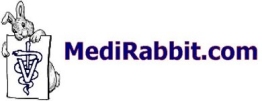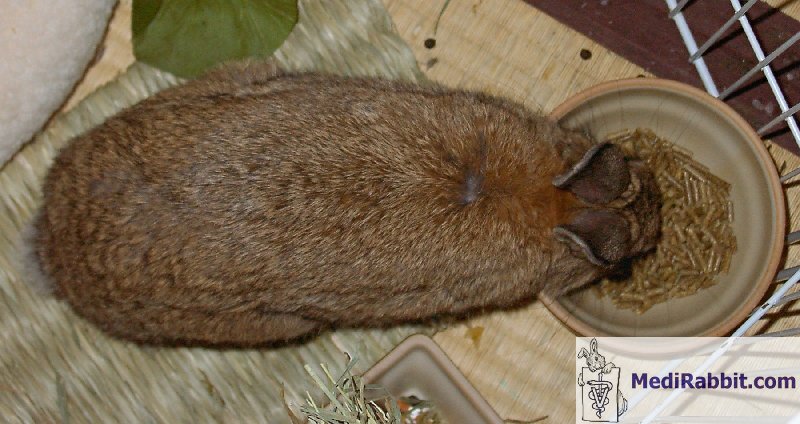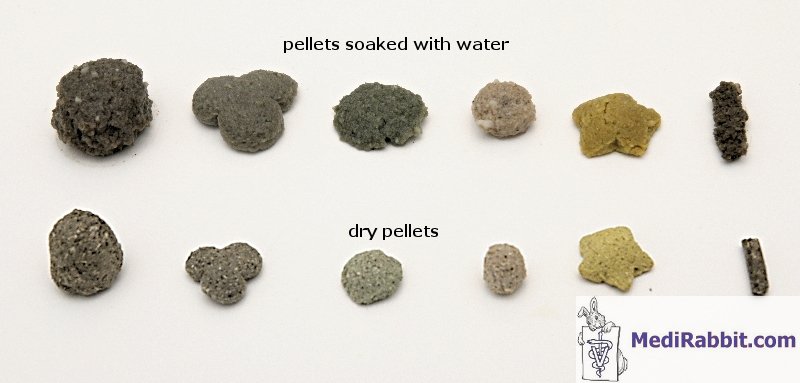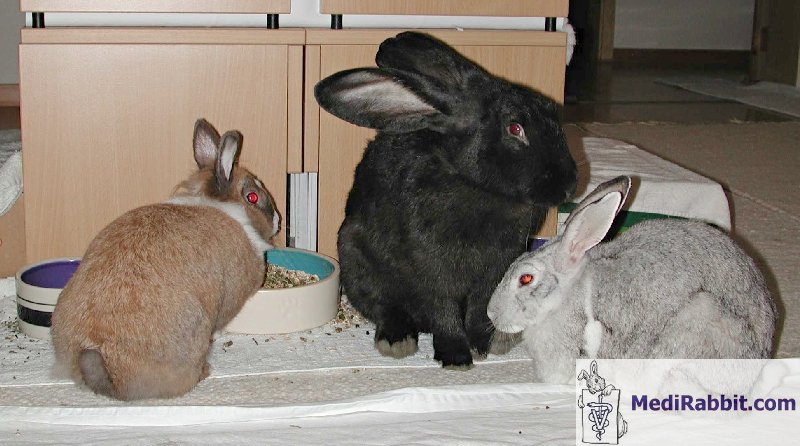Feeding the house rabbit 7: Pellets
Camilla
Bergstrøm
MediRabbit.com is funded solely by the
generosity of donors.
Every donation, no matter what
the size, is appreciated and will aid in the continuing research of medical care
and health of rabbits.
Thank you
|
|
Pellets are composed of a mixture of raw products that have
different nutritive values. The concentrated source of energy provides
nutrients, minerals and vitamins necessary to rabbits to grow and stay
healthy. Even though fresh foods also contain vitamins and minerals, they
lack certain nutrients such as essential fatty acids. The low concentrations
of these nutrients do not necessarily harm the rabbit on short term, but over
time it will have a negative effect on its general heath.
Tal Saarony The raw material is reduced to
a size that ensures the production of high-quality pellets, but also takes into
account a good digestibility and absorption of nutrients in the digestive
tract of rabbits. While pelleted food ensures the daily
requirements of minerals and vitamin, it does not provide water, which they
will absorb massively. It must thus be ensures that a rabbit has free access
to clean water, either in a bottle or a stone crock, or both. If a rabbit
does not drink enough to wet the chewed pellets, water will be drained from
the body tissues.
MediRabbit
Pellets take up a lot of water: dry pellets (front row) are
small and compact, but swell several times their original size after
absorbing water (top row)
In some parts of the world,
good quality pellets are hard to find. A good brand should have particles
ranging between 2.5 and 4 mm. When the particles are smaller, the digesta will take longer to pass through the intestine
and more particularly in the cecum. Increased fermentation of food in the
cecum can lead to digestive disorders such as diarrhea. Pellets should
contain minimum 18 % fiber, 12-14 % protein, maximum 3 % fat and between 0.5
and 0,8 % calcium. A rule of thumb is that the fiber
content always should exceed the protein content.
Small amounts of molasses may
be added to the pellet mixture. To avoid a sugar overload in the digestive
tract of rabbits, these are caramelized. The extrusion process will
lead to the denaturation of protein and starch. The
structure of proteins will be broken, but not that of amino acids. This
allows, furthermore, killing pathogen bacteria that may infect food, such as Salmonella
sp. The starch content in pellets should be low. Often starches of cereal
origin will be gelatinized to increase digestibility and avoid digestive
disorders in young rabbits. Growing rabbits (under 6 months) must be given unlimited pellets.
After 6 to 9 months of age, depending if a small or large breed, the
recommended amount of pellets is 1/4 to 1/2 cup pellets per 6 lbs. body
weight. Again, it’s important to consider the individual need of each rabbit.
Some have a fast metabolism, and will need more than the recommended amount.
Some rabbits easily gain weight and need less. The same goes for breeding
does, rabbits suffering from disease, or recovering from surgery. Spayed and
neutered rabbits might need fewer pellets.
MediRabbit
The diet of Stampi, Adar and Grisjje includes pellets
Pellets are an important part of a healthy diet, and a balanced source of vitamins and minerals. But pellets contain many calories and your rabbit can get overweight if they are fed too much. Restriction and knowing your rabbit is important. Some studies done by several experienced rabbit owners led to the conclusion that rabbits fed measured amount of pellets twice a day appeared to suffer much more frequently from digestive problems such as gas or stasis, in spite of the availability of hay, as compared to rabbits who have a constant free access to pellets. It is suspected that rabbit fed portion are hungry and wait for the pellets. Once given, they will eat them rapidly, not taking the time to chew them properly and to mix the ingesta with saliva. |
e-mail: info@medirabbit.com






